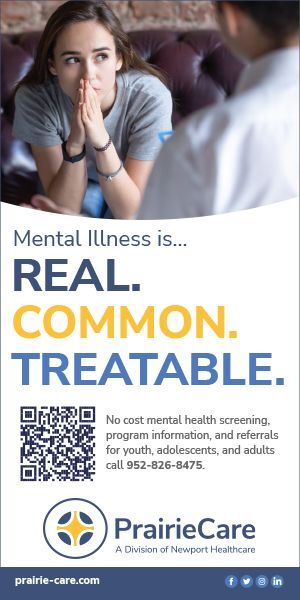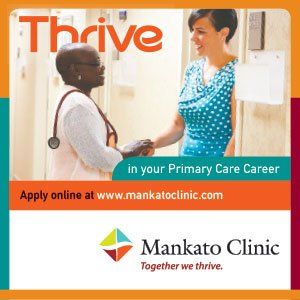n May, Twin Cities Orthopedics (TCO) announced that a group of 10 rheumatologists, including myself, were joining the practice. As a rheumatologist for almost 12 years in the Twin Cities area, including serving as our department chair at our former practice for the past five years, this transition marked a significant and exciting personal milestone.
Senior Care
A Bold New Partnership
Joining rheumatology with orthopedics
BY Paul Sufka, MD
Throughout my career, I have maintained an active social media presence, primarily on Twitter (@psufka), using the platform both to keep pace with developments in the field of rheumatology and to widen my professional network. My engagement in social media extended into the professional realm as well, where I was active in the American College of Rheumatology’s Communications & Marketing Committee, which led to my current role as the Social Media Editor for a handful of the American College of Rheumatology’s official journals, namely Arthritis & Rheumatology, Arthritis Care & Research, and ACR Open Rheumatology. Additionally, I was also a co-founder and served as Technology and Marketing Lead of the COVID-19 Global Rheumatology Alliance, where we built a secure, de-identified, international case-reporting registry where doctors could enter information about their rheumatology patients who had COVID-19, leading to numerous publications providing valuable information to help guide the care of rheumatology patients during the pandemic.
Rheumatology is a field specializing in diagnosing and treating musculoskeletal diseases that often have systemic involvement. It is distinct given the complexity and heterogeneity of presentations of autoimmune and inflammatory disorders. These often require an extensive and complicated diagnostic process that can lead to diagnoses such as systemic lupus erythematosus, Sjögren’s syndrome, dermatomyositis, or systemic vasculitis. Additionally, patients with these diagnoses require long-term management, so rheumatologists develop relationships with these patients that can extend a decade or more. This, combined with barriers to patient access such as a shortage of rheumatologists, especially in rural or underserved areas, and the high costs of long-term care, can significantly delay appropriate treatment. However, through patient advocacy groups, online communities and medical conferences, the rheumatology community fosters a collaborative environment for patients to share experiences and learn more about their conditions. Misconceptions are also prevalent in this field, with many mistakenly believing rheumatic diseases primarily affect the elderly or are simply results of aging, potentially leading to delayed diagnoses and underestimation of the severity of these conditions.
Rheumatologists develop relationships with these patients that can extend a decade or more..
Serving Overlapping Needs
When I shared the news of the new association with TCO on Twitter, I was asked why rheumatology would opt to align with an orthopedic practice. I explained that the majority of my patients have overlap with orthopedics. We can provide better care to more patients working as part of a team-based system in which each physician can collaboratively utilize his or her specialized skills. While this partnership may initially appear out of the ordinary to some, it offers a promising model in a field that is urgently trying to overcome the challenge of a limited number of rheumatologists in the United States.
Delivering medical care in an effective manner necessitates the adoption of new care-delivery models, which is something we found exemplified at TCO. Coming to this group as rheumatologists, we were impressed by their approach of placing physicians at the helm of decision-making, thereby enabling us to prioritize patient care in all our decisions. From our standpoint, it was highly innovative to follow the model that orthopedic surgeons were using within the practice, which involves constructing a supportive team immediately around each physician, maximizing their efficiency and allowing them to concentrate almost entirely on direct clinical care. Moreover, we were pleased to find an optimal number of highly capable and agile administrators within the group, who provided invaluable support in navigating and implementing this model effectively.
Innovations that are occurring, given the introduction of rheumatology to the group, include the development of an in-house lab service. For rheumatologists who frequently order a multitude of lab tests, this will allow us to better serve our patients at our locations and improve the patient experience.
Furthermore, actively participating in the growth and development of these innovative projects provides our group with an incredibly exhilarating opportunity.
Directly integrating rheumatology with orthopedic care provides a significantly enhanced experience for patients. Musculoskeletal complaints are a prevalent reason for seeking medical care, and while most cases are attributed to mechanical causes like overuse, degenerative diseases or trauma, a portion of these cases involve new-onset inflammatory conditions such as rheumatoid arthritis, psoriatic arthritis, gout or other conditions that are better managed by rheumatologists. By establishing a seamless connection between our two specialties, we can expedite and coordinate care for these patients, enabling them to regain normal function as swiftly as possible.
Rheumatologists and orthopedic surgeons often treat patients with similar conditions but approach them from different perspectives. Take the example of a patient with rheumatoid arthritis who initially presents with inflammatory joint symptoms managed by a rheumatologist. The rheumatologist focuses on disease management, utilizing medications, lifestyle modifications and physical therapy among other treatments. However, as time progresses, the patient may develop joint deformities or severe arthritis necessitating orthopedic surgical intervention. Furthermore, thanks to advancements in rheumatologic treatments, many patients with rheumatologic conditions can maintain an active lifestyle and may experience typical sports injuries that are better suited for orthopedic care. This collaborative approach allows for the comprehensive and holistic management of patients, addressing both the underlying systemic condition and any subsequent orthopedic needs that may arise.
We can provide better care to more patients working as part of a team-based system.
Specialist Shortages
One of the most significant challenges facing the field of rheumatology is the declining number of physicians in the workforce. The American College of Rheumatology’s workforce study has shed light on this pressing issue, revealing an imminent shortage in the field. In 2015, there were only 4,997 adult rheumatologists in the United States, which fell short of meeting the estimated demand for 6,115 physicians needed to provide adequate rheumatology care.
Projections from this study paint an even more concerning picture of the future. By 2025, it is anticipated that the total number of adult rheumatologists will further decline to approximately 3,654, even though the demand for their services will increase to a staggering need for 7,490 physicians. Looking ahead to 2030, the situation could worsen, with an estimated 3,455 rheumatologists available to meet the surging demand for 8,184 physicians. The potential implications of this growing disparity between supply and demand in rheumatology care emphasize the urgent need to address this critical issue.
The shortage of rheumatologists is driven by several factors, with the aging workforce and limited training positions being key contributors. A significant portion of current rheumatologists are approaching retirement age, which poses a significant loss of care considering that the majority of rheumatology patients require lifelong management for their chronic autoimmune or inflammatory conditions. Consequently, when retiring physicians are replaced, new physicians often have full patient panels early on, making it challenging for new patients to find care within these practices. Unfortunately, there has been an insufficient influx of new rheumatologists entering the field to bridge this impending gap. The situation is further exacerbated by the increasing demand for rheumatology services due to the growing population of older adults with rheumatic diseases.
Currently, there are about approximately 257 adult rheumatology fellowship training positions available in the United States. However, since 2010 there has been an annual retirement rate of anywhere between 185 to 270 rheumatologists, exacerbating the discrepancy between the number of practicing rheumatologists and the rising demand for their services. As training positions represent a significant limiting factor in the worsening shortage of rheumatologists, the American College of Rheumatology has prioritized various advocacy efforts to increase the number of these positions and secure additional funding for training programs.
Additionally, in efforts to sustain the existing workforce and avoid excessive early retirement, the American College of Rheumatology has put additional focus on physician burnout, which was accelerated by the COVID-19 pandemic. The stressors associated with the modern health care industry including administrative burdens, electronic health record demands, long working hours and the emotional toll of patient care, have led to widespread disillusionment among many physicians. In rheumatology, this issue is especially pronounced, with increased workloads and the combined pressure of complex patients resulting in an environment ripe for burnout. One important way this is being addressed is by helping physicians improve health care delivery because the modern health care industry often leaves many physicians feeling that they can no longer provide care to patients in ways that made them pursue medicine in the first place.
A Brighter Shared Future
Enhancing health care delivery cannot be a top-down initiative alone. It needs to be cultivated at the local level as well. It’s at this grassroots level that the real impact of these efforts is felt most acutely by physicians and their patients. This is where innovative models, such as the one we’re pioneering come into play. Merging rheumatology with orthopedics is an example of a novel approach to streamlining patient care and maximizing physician efficiency. Our integrated model reduces the administrative load for physicians and allows us to cater to the complex needs of our patients more effectively. Moreover, this approach allows our patients, who frequently have musculoskeletal problems that require the assistance of orthopedics, a seamless experience.
In effect, by reducing burnout and optimizing care, we’re preserving the essence of why many of us chose medicine in the first place, the ability to make a tangible difference in our patients’ lives. As the field of rheumatology grapples with the challenges of workforce shortages, we are developing a promising blueprint for others to follow. We believe that this could serve as an inspiring example for other practices, demonstrating how operational innovation and partnerships between related fields can lead to better patient care.
We firmly believe that our novel approach will not just improve the care of rheumatology patients but also enhance physician job satisfaction. Our decision to join TCO wasn’t taken lightly. It says a lot that our entire group of 10 well-established rheumatologists chose to move forward together, seeing the opportunity this collaboration affords in advancing our careers alongside each other. Our move sends an important message to the wider medical community. It underlines our commitment to breaking down silos and promoting collaboration among specialties for the betterment of patient care. It challenges the notion of traditional practice boundaries and encourages other medical professionals to consider the benefits of such innovative partnerships. We hope to serve as a catalyst for other practices to explore similar collaborations, ushering in a new era of health care that is more integrated, efficient and patient-centered.
The excitement isn’t limited to our team. Patients, too, seem to be eagerly embracing our new group. In fact, we’ve received an overwhelming response with over 1,000 patients scheduled prior to my first day of clinic. This enthusiasm is a testament to the potential of our model to better meet the needs of our patients, and we eagerly anticipate the opportunity to deliver on that promise.
Paul Sufka, MD,
is a rheumatologist at Twin Cities Orthopedics.
MORE STORIES IN THIS ISSUE
cover story one
Navigating Drug Shortages: Preparedness and patient advocacy
By David J. Margraf, PharmD, PhD and Stephen W. Schondelmeyer, PharmD, PhD
cover story two
The New Noncompete Agreement Laws: What they mean for physicians
By Jennifer A. Forbes, JD and Benjamin J. Kramer, JD



















